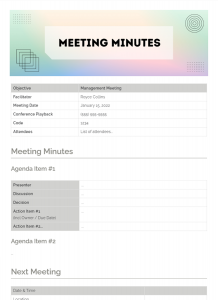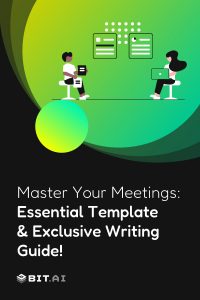You walk into a virtual meeting, coffee in hand, ready to tackle the next big project management task. The discussion is lively, ideas are flowing, and decisions are being made left and right. Fast forward a week, and chaos ensues. Questions arise—“Did we decide on the deadline?” “Who was supposed to follow up on that task?” “Wait, did we even discuss that?”
This is exactly why meeting minutes are so important. They capture every crucial detail—what decisions were made, who said what and who’s responsible for what. But let’s be real—writing minutes can be a nightmare. Details slip through the cracks, formatting is a mess, and reviewing them? Ugh.
Don’t worry. This guide has everything you need:
- Best practices for clear, concise documentation
- A meeting minutes template
- How ai makes minute-taking effortless
🧠 Did You Know?
Teams that document meeting minutes are 3X more likely to meet deadlines and follow through on action items.
The “DADADA” Method for Effective Meeting Minutes
Great meeting minutes aren’t just notes—they’re a structured system that keeps discussions organized and ensures accountability. Follow the DADADA method to make sure your minutes capture everything that matters:
- Date & Time – Because “sometime last week” isn’t helpful: Recording the exact date and time helps track when decisions were made, especially for recurring meetings.
- Attendees – So you know who to chase for follow-ups: Listing attendees clarifies who was involved in key discussions and who to check with for updates.
- Discussion Summary – Skip the fluff, keep the facts: Summarize key points, decisions, and perspectives—no one wants to sift through a novel.
- Agenda – No more meetings that go wildly off track: A well-defined meeting agenda keeps conversations focused and helps compare planned vs. actual discussions.
- Decisions Made – Because “I thought we agreed on this” is never fun: Clearly state what was decided, who approved it, and any conditions attached.
- Action Items – Otherwise, it’s just talk: Assign tasks, set deadlines, and track responsibilities to turn discussions into results.
Read this next 👉 Planning Meetings Effectively: Steps & Best Practices to follow!
Formal vs. Informal Meeting Minutes: What’s the Difference?
- Formal Minutes – Used for board meetings, executive discussions, and legal documentation. These follow a structured, professional format.
- Informal Minutes – Ideal for internal team meetings. They’re more flexible often using bullet points as well as summaries instead of detailed transcripts.
Now that we understand the essential elements of a meeting minutes format, let’s explore how Bit.ai makes the process seamless.
Top 5 Practices for Meeting Minutes
To create high-quality board meeting minutes, consider the following best practices:
1. Be Clear and Concise
Avoid superfluous details and keep the minutes focused on only the most important facts. It should be concise, precise, and to the point so that readers can rapidly comprehend crucial lessons without having to wade through a lot of information. The idea is to give users an organized overview, not a full transcript.
2. Use Bullet Points for Readability
Breaking down information into bullet points improves readability and makes it easier to scan important details. Bullet points help separate key topics, making it clear what was discussed, decided, and assigned. This is particularly useful when meetings cover multiple agenda items and require structured documentation.
3. Record Decisions, Not Conversations
Meeting minutes should be summarizing the outcomes of conversations rather than recording every word that has been stated. Instead of documenting lengthy conversations, you shoud focus on summarizing conclusions, agreements, and next steps. This keeps the minutes relevant and prevents them from becoming cluttered with unnecessary details.
🗒️ Quick Note: Minutes are not for recording every word—they’re for recording every decision.
4.Use Action Verbs
To ensure clarity, use strong action verbs such as “approved,” “assigned,” “scheduled,” “reviewed,” or “implemented.” This makes the minutes more actionable and avoids unclear or passive language, which could cause to confusion. Clear wording ensures that duties and future tasks are easy to understand.
5.Distribute Minutes Promptly
Timely distribution of meeting minutes ensures that everyone stays informed and aligned. Delays in distributing minutes can result in miscommunication, missed assignments, and confusion over responsibilities. Teams can retain momentum, make choices, and meet project deadlines by disseminating the document as soon as possible.
The template may need to be modified depending on the industry and team structure. Bit.ai offers a versatile solution for documenting board meeting minutes, project management discussions, and virtual meeting stand-ups.
With best practices in mind, together let’s look at how Bit.ai can improve minute writing management even more!
🎯 Pro Tip
No more doc-hunting ➡️ Try Bit.ai’s smart workspaces to Keep your meeting minutes sorted by team or project
Simplify Meeting Minutes with Bit.ai

Minutes writing format can be a time-consuming process, but Bit.ai’s AI-powered Meeting Minutes Prompt streamlines it efficiently. Below is a ready-to-use minutes of meeting sample to get you started:
Meeting Minutes Template
Meeting Minutes
Date: [Insert Date]
Time: [Insert Time]
Location: [Physical/Virtual Meeting]
Attendees: [List Names]
Agenda:
- [Agenda Item 1]
- [Agenda Item 2]
Discussion Summary:
- [Summarize key points]
Decisions Made:
- [List decisions]
Action Items:
- [Task] – [Owner] – [Deadline]
Bit.ai, the smartest document collaboration platform goes beyond a conventional corporate minutes template by giving AI-powered tools to automatically structure formal meeting minutes, ensuring accuracy and completeness!
Additionally, its real-time collaboration feature allows multiple team members to contribute simultaneously, making documentation more efficient.
To further enhance your meeting minutes format, let’s look at best practices and industry-specific adaptations.
Read this next 👉 What is Lead Time In Project Management and How to Reduce it?
6 Ways to Elevate Your Meeting Minutes with Bit.ai
Forget scattered notes and forgotten action items—Bit.ai transforms meeting documentation into a structured, collaborative, and actionable resource.
1. Auto-Formatting & Smart Structuring
Stop wasting time on fixing headers and bullet points. Use Bit.ai’s intelligent structuring tools for automatically format your meeting minutes, which help in a professional and polished appearance with no manual effort.
2. AI Genius Writer
Struggling to summarize key points? Let AI Genius Writer do the heavy lifting! With about 300+ pre-designed prompts, whether it’s action items, discussion highlights, or follow-ups, this AI-powered assistant helps you craft well-structured, clear meeting minutes effortlessly!
3. Real-Time Collaboration
Keep the entire team on the same page—literally! Multiple users can now edit, refine, and contribute to meeting documentation simultaneously, capturing key decisions, assigning tasks, and keep the whole discussion transparent.
4. Easy Sharing with Trackable Links
Make your meeting notes available while preserving control. Share minutes securely using trackable links and guest access, allowing you to track engagement and keep the proper people informed.
5. Wiki Publishing for Centralised Meeting Notes
Convert your meeting minutes into a live, searchable wiki that changes over time! Share them via live links, or trackable links, or embed them directly onto your website. Anyone can easily identify important talks, choices, and follow-ups thanks to the built-in search functionality.
6. Design Consistency
No more mismatched fonts or clunky layouts! Set a unified design theme, and every new subpage will follow suit automatically—keeping all meeting documentation sleek, professional, and easy to navigate.
With Bit.ai, meeting minutes aren’t just notes—they’re a living, collaborative, and organized knowledge hub that keeps teams aligned and action-driven.
Read this next 👉 Project Documentation: What is it & How to Manage it?
Streamline meeting minutes with Bit.ai.
Meeting minutes are essential for maintaining clarity, accountability, and efficiency in professional contexts. However, typical documentation approaches might be inefficient and inconsistent.
Bit.ai streamlines meeting minutes authoring with AI-powered automation, smart formatting, and real-time collaboration. Using Bit.ai, teams may improve project management, assure continuous communication, and remove the chance of forgetting important facts!
Try Bit.ai’s Meeting Minutes AI Prompt today and experience effortless note-taking!
FAQs About Meeting Minutes
- What’s the difference between meeting minutes and meeting notes?
A meeting minutes format provides a structured record of discussions, decisions, and action items, while meeting notes are informal and less detailed. - How long should meeting minutes be?
Formal meeting minutes should be concise, typically one to two pages, covering essential points and action items. - Can meeting minutes be used as legal documents?
Yes, board meeting minutes serve as official records and can be used for legal and compliance purposes. - Who should approve meeting minutes?
A meeting minutes format is usually reviewed and approved by the meeting chair or senior management before being circulated.
Take control of your project management meetings with Bit.ai and ensure that every discussion translates into actionable results.
Read out these artices 👉
Enhancing Team Productivity Through Real-Time Collaboration
9+ Benefits of Collaboration For Teams and Businesses!
Best Team Engagement Activities To Energize Your Workplace
10 Corporate Wiki Best Practices and How to Implement Them?
10 Proven Teamwork Strategies to Improve Collaboration & Communcation



